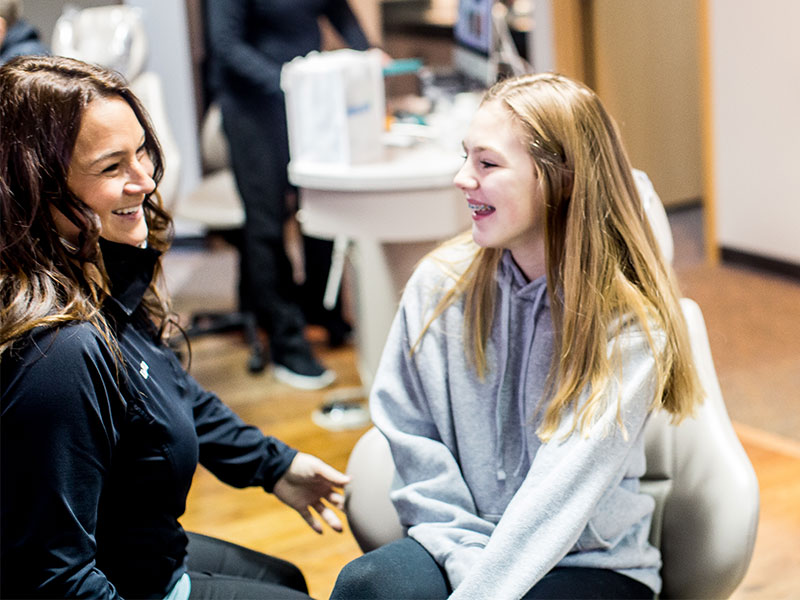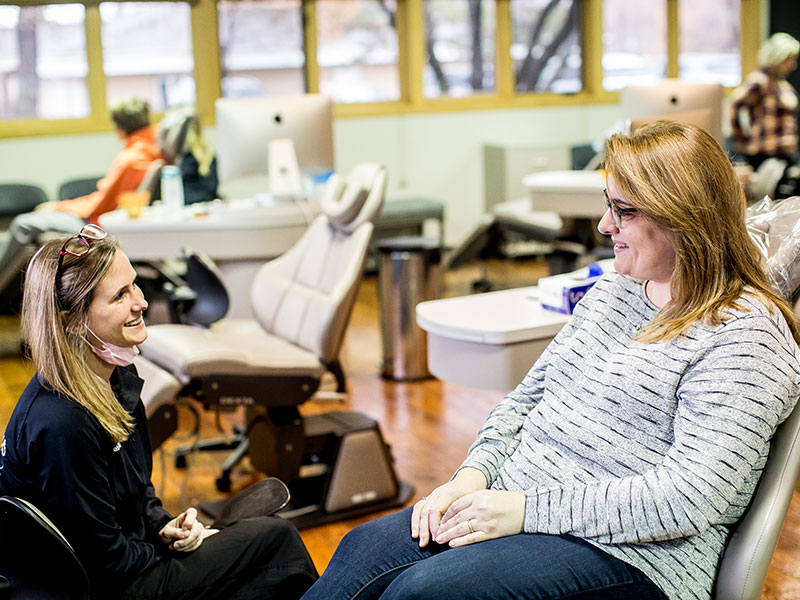What We Do
At Zirbel Orthodontics, when you step through our doors, we will help you find the best type of treatment for your smile. We treat a wide range of orthodontic cases for children, teens, and adults including crowding, open bites, overbites, missing adult teeth, the spacing of teeth, overjets, and Phase I, teens & adults.
Quick Links
Who we treat

Phase I Treatment
The American Association of Orthodontists recommends visiting the orthodontist around age seven. By this age, most children have a mix of baby teeth and adult teeth, making it easier for the orthodontist to diagnose and correct tooth and jaw problems sooner and without surgery.

Teen & Adult Treatment
If you or your child did not receive treatment at age 7, no need to worry! Teens and adults are also candidates for orthodontic treatment, which can be started at any time.
What We Offer
Traditional Braces
One of the most common ways to straighten your teeth is traditional metal braces. Braces are offered for children, teens, and adults.
Clarity™ Ceramic Brackets
Translucent ceramic Clarity 3M brackets can give you the same orthodontic result without the need for metal braces. These small brackets move teeth with the same efficiency as traditional braces and are safe to use for patients of all ages. These brackets resist staining and discoloration throughout your treatment, and colorful elastic ties can be added for fun!
Retainers
Zirbel Orthodontics offers both removable and fixed bonded retainers for when you finish your treatment. It’s important that you keep your newly perfected smile in the best shape possible!
Retainer types
Removable Retainers
These retainers are made of clear plastic, rendering them discreet and nearly invisible. They are easily removable and very durable, making them a great option for most patients.
Bonded Lingual Retainers
Otherwise known as “permanent retainers,” these retainers consist of a wire placed behind the teeth, making it invisible! It is bonded to the back of your teeth, meaning you never have to take it out or remember to put it back in. Your teeth will remain straight without having to remember to wear a retainer, offering peace of mind!
Memotain®
Memotain® is a custom-fit, precision bonded lingual retainer that offers maximum comfort. It is created using a digital map of your teeth, rendering an exact fit.
Surgical Orthodontics
Surgical orthodontics combines orthodontic treatment (braces) with orthognathic surgery (jaw surgery). It is used to correct severe cases that include bad bites, jaw bone abnormalities, and malocclusion. Oral and maxillofacial surgery focuses on treating complex craniofacial cases that involve the mouth, jaw, face, and skull.
Dentofacial Orthopedics
While orthodontics entails the management of tooth movement, dentofacial orthopedics involves the guidance of facial growth and development, which occurs largely during childhood.
Interested in a discreet treatment option?
Invisalign® may be the right path for you!
Check out our happy patients before and after their treatment!
What To Do In An Emergency
If any part of your orthodontia becomes loose or breaks, call our office to make an appointment to come see us. If the band or bracket is still attached to the archwire, leave it just as is and do not try to pull it off or connect any elastics to it. If it is causing any irritation, you can use orthodontic wax to cover it or move it back into place with a pencil eraser, Q-tip, or small pair of tweezers (never your fingers). If the bracket or band comes off completely, make sure you keep it and bring it with you to your next appointment.
Helpful Videos
How to Adjust and Clip Your Wire
Has a bracket fallen off of your teeth and your wire is poking your mouth? This video will help you alleviate any discomfort caused by a wire sticking out while you wait to see your doctor.
How To Ease Discomfort of a Rubbing Bracket or Wire
Sometimes brackets and wires can rub and cause discomfort. Follow the instructions in this video in the case of a bracket or wire rubbing in the mouth.
Sliding Your Wire Back Into Place
Watch these helpful instructions on how to slide your own wire back into place if it shifts or slides out of a bracket.
Emergency Tips
Food Caught Between Teeth
This is not an emergency but can be a little uncomfortable for the braces wearing patient. It is easily fixed with a piece of dental floss. Try tying a small knot in the middle of the floss to help remove the food, or use an interproximal brush or toothpick to dislodge food caught between teeth and braces.
Ligatures (Color or Metal Ties) Come Off
Tiny rubber bands or small, fine wires, known as ligatures, hold the wire to the bracket. If a rubber ligature should come off, you may be able to put it back in place using sterile tweezers. If a wire ligature comes loose, simply remove it with sterile tweezers. If the wire ligature is sticking out into the lip but is not loose, it may be bent back down with a Q-tip or pencil eraser to eliminate the irritation. Of course, when one ligature pops off or breaks, others may follow. Be sure to examine all ligatures. If you have a missing or broken ligature please notify our office so we can determine the appropriate steps. If a rubber or wire ligature is lost, notify the orthodontist so that they may advise whether the patient should be seen.
Discomfort
It’s normal for a patient to have discomfort for a day or two after braces or retainers are adjusted. But it can make eating uncomfortable. Be assured that the discomfort is both normal and temporary. Encourage soft foods.
Mouth Sores
Some patients are susceptible to episodes of mouth sores. While braces do not cause them, they may be precipitated or exacerbated by an irritation from braces. One or several areas of ulceration of the cheeks, lips or tongue may appear. This is not an emergency, but may be very uncomfortable for the patient. Prompt relief may be achieved by applying a small amount of topical anesthetic (such as Orabase or Ora-Gel) directly to the ulcerated surface using a cotton swab. Instruct the patient to reapply as needed.
Irritation of Lips or Cheeks
Sometimes new braces can be irritating to the mouth, especially when the patient is eating. A small amount of non-medicinal relief wax makes an excellent buffer between metal and mouth. Simply pinch off a small piece and roll it into a ball the size of a small pea. Flatten the ball and place it completely over the area of the braces causing irritation. The patient may then eat more comfortably. If the wax is accidentally ingested, it’s not a problem. The wax is harmless. The patient should rinse with warm salt water to help heal mouth sores.
Protruding Wire
Occasionally, the end of a wire will work itself out of place and irritate the patient’s mouth. Use a Q-tip or pencil eraser to push the wire so that it is flat against the tooth. If the wire cannot be moved into a comfortable position, cover it with relief wax. (See Irritation of Lips or Cheeks above for instructions on applying relief wax.) Please make the orthodontist aware of the problem. In a situation where the wire is extremely bothersome and the patient will not be able to see the orthodontist anytime soon, you may, as a last resort, clip the wire. Reduce the possibility of the patient swallowing the snipped piece of wire by using folded tissue or gauze around the area. Use a pair of sharp clippers and snip off the protruding wire. Relief wax may still be necessary to provide comfort to the irritated area.
Loose Brackets, Wires or Bands
If the braces have come loose in any way, please notify us so we can determine the appropriate next steps. Brackets are the parts of braces attached to teeth with a special adhesive. They are generally positioned in the center of each tooth. If the bracket is off-center, the brace may be loose. The bracket can become loose if the patient has eaten one of those hard or crunchy foods orthodontic patients are instructed to avoid, or if the mouth is struck while at play. (Patients, especially those with braces, should wear a protective mouthguard while playing sports.) If the loose bracket has rotated on the wire and is sticking out and the patient cannot immediately come to the orthodontist, do a temporary fix to alleviate discomfort and prevent further damage, but take care to prevent swallowing or another injury. To put the bracket back in place, use sterile tweezers to slide the bracket along the wire until it is between two teeth. Rotate the bracket back to the proper position, then slide it back to the center of the tooth.
Piece of Appliance is Swallowed
This is rare, but when it does happen, it can be fairly alarming to the patient. Encourage your patient to remain calm. If the patient is coughing excessively or having difficulty breathing, the piece could have been aspirated. If you are able to see the piece, you may carefully attempt to remove it. But do not make the attempt if you could cause harm. If appropriate under the circumstances, examine the patient’s braces for problems that may result from the missing piece, such as looseness or irritation, and treat as specified above. If you are unable to see the piece and believe it may be have been aspirated, notify our orthodontist immediately so that they can determine the next steps.
Call Our Office
While actual emergencies are rare, if a traumatic event occurs contact any of our offices as soon as possible. In these situations, X-rays are often necessary to determine the extent of the injury or incident and to determine whether or not the orthodontic appliances have been damaged.